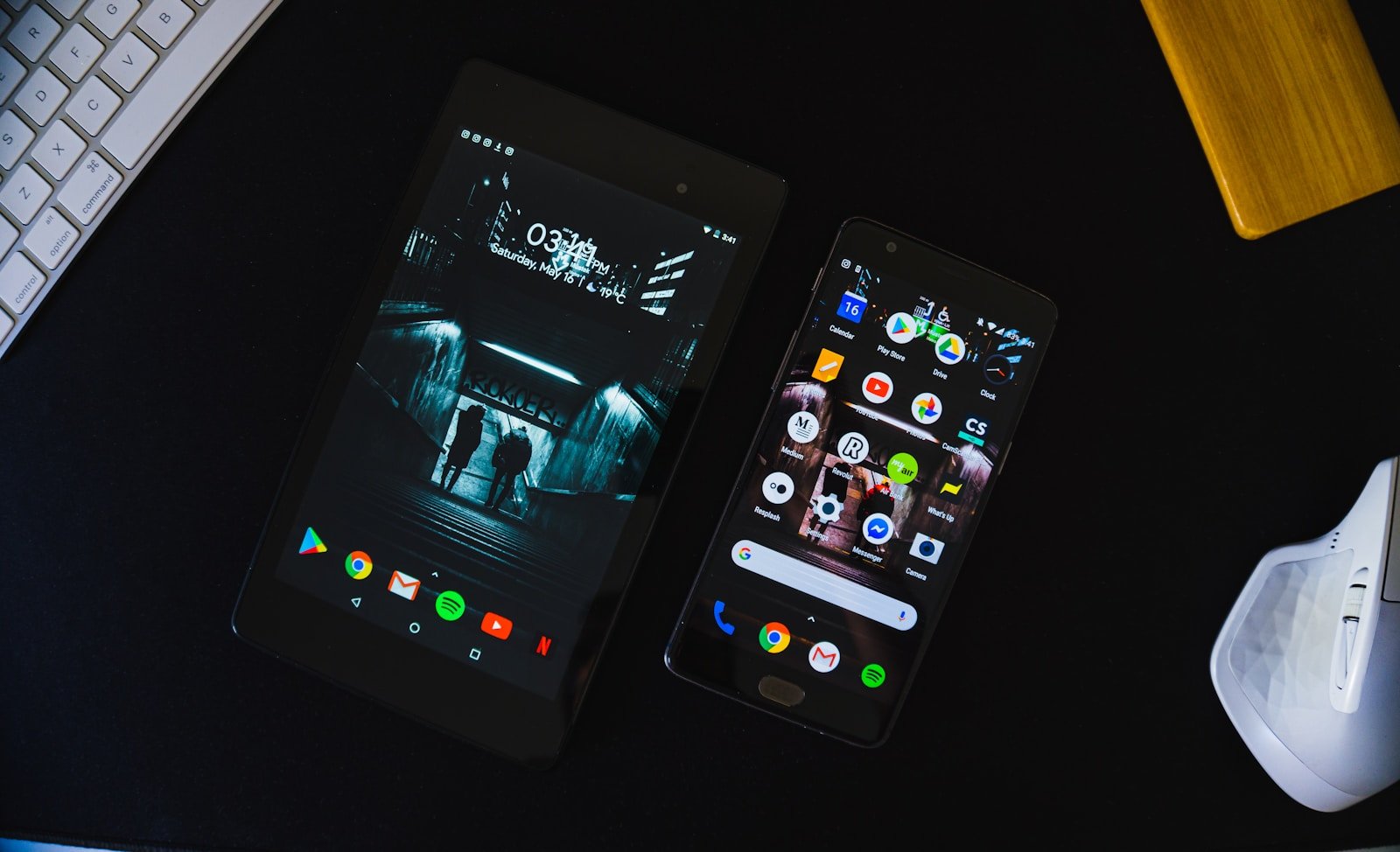Ever needed to work on two apps at once on your Android phone? Split screen mode lets you view and use two apps side by side, making your phone more useful than ever. Android’s split screen feature allows you to open two applications simultaneously, helping you multitask without constantly switching between apps.
Using split screen is simple on most Android phones. You can watch videos while texting friends, check your calendar while writing emails, or copy information from one app to another. This handy feature works on most newer Android devices, though the steps to use it may differ slightly depending on your phone model.
The split screen function has become more powerful over time. Some phones even offer added options like adjusting the size of each app window. Apps like Split Screen can bring this function to more devices, and future Android versions may include even more windowed mode options.
Split Screen Guide on Android: How to Use Split Screen Mode
Split screen mode on Android allows you to view and use two apps simultaneously, boosting productivity by multitasking efficiently. Here’s a simple step-by-step guide to enable and use split screen on your Android device.
How to Enable Split Screen on Android
Step 1: Open Recent Apps
- Tap the Recent Apps button (usually the square or the three-line icon) or swipe up and hold (gesture navigation) to open the multitasking view.
Step 2: Select the First App
- Find the app you want to use in split screen.
- Tap the app icon at the top of its preview window.
Step 3: Choose “Split Screen” or “Open in Split Screen View”
- From the dropdown menu, select Split Screen or Open in split screen view.
Step 4: Select the Second App
- The first app will move to the top (or left) half of the screen.
- The recent apps menu will remain open on the other half.
- Tap the second app you want to open in the other half of the screen.
Adjusting Split Screen
- Drag the divider bar between the two apps to resize each window as needed.
- Swipe the divider all the way to the top or bottom (or left/right) to exit split screen mode.
Tips for Using Split Screen
- Not all apps support split screen mode; if an app doesn’t appear in the recent apps list or won’t open in split screen, it may not be compatible.
- You can use split screen in both portrait and landscape orientations.
- Some devices also support split screen in floating window or pop-up view for more flexible multitasking.
How to Exit Split Screen Mode
- Drag the divider bar fully to the top or bottom of the screen.
- Or press the Home button to return to the home screen, which closes split screen.
Using split screen on Android can greatly improve your multitasking capabilities, whether you’re browsing while chatting or watching videos while taking notes.
Key Takeaways
- Split screen lets you run two apps at once on your Android phone for better multitasking.
- Most Android phones have split screen built in, usually accessed through the recent apps menu.
- You can adjust how much space each app takes up by dragging the divider between the apps.
Understanding Split Screen on Android
Split screen mode on Android lets users run two apps side-by-side on their device screen. This feature has changed over time with Google’s design philosophy and user interface improvements.
Evolution of User Interface (UI)
Android’s split screen function has gone through several changes since its introduction. The feature first appeared in some manufacturer interfaces before becoming an official part of Android in version 7.0 (Nougat) in 2016.
Early versions required users to open the recent apps menu and drag apps to designated areas. The process wasn’t very smooth or user-friendly.
Over time, Google made the feature easier to use. On newer Android versions, users can access split screen by:
- Opening the recent apps view
- Long-pressing an app icon
- Selecting “Split screen” from the menu
Some phone makers like Samsung added their own versions with extra options. These manufacturer-specific features sometimes let users force apps to work in split screen even when they weren’t designed for it.
Material Design and Split Screen
Google’s Material Design guidelines shaped how split screen works on Android devices. Material Design focuses on clean layouts and smooth transitions that help users understand what’s happening on screen.
In split screen mode, Material Design principles ensure apps resize properly. Content adjusts to fit the new space rather than getting cut off or becoming unusable.
Apps built with Material Design respond better to split screen. They know how to reorganize buttons, text, and images when given less screen space.
Not all apps work well with this feature. Some apps like Facebook Messenger don’t officially support split-screen mode, making the experience inconsistent.
Android 12 and newer versions improved this with better visual cues. When entering split screen, animations show the screen dividing, helping users understand what’s happening.
Getting Started with Split Screen
Split screen is a handy feature on Android devices that lets you view and use two apps at the same time. This multitasking tool works on many phones and tablets, though the exact steps may vary slightly by device.
Devices Supporting Split Screen
Most modern Android phones and tablets support split screen functionality. This feature became standard with Android 7.0 (Nougat) and continues in newer versions. Samsung, Google Pixel, OnePlus, and Xiaomi devices all offer this capability.
Not all apps work with split screen mode. Some video streaming apps or games might not function properly when sharing the screen. The best apps for split screen are messaging apps, browsers, note-taking apps, and social media platforms.
For the best experience, devices with larger screens like tablets or bigger phones provide more usable space when running two apps. This gives each app enough room to be useful.
How to Activate Split Screen Mode
To use split screen on most Android devices, follow these simple steps:
- Open the first app you want to use in split screen
- Tap the recent apps button (usually a square or swipe up from the bottom on newer models)
- Find the app you’ve just opened in the list of recent apps
- Press and hold the app icon at the top of its card or tap the three dots that appear
- Select “Split screen” from the menu
- Choose the second app you want to use from the list of recent apps
Once activated, you’ll see a divider line between the two apps. You can adjust this divider by dragging it up or down to give more screen space to one app.
To exit split screen mode, simply drag the divider all the way to the top or bottom of your screen, or use the back gesture repeatedly.
Using Split Screen for Productivity
Android’s split screen feature lets you work with two apps at once, making your phone more useful for getting things done. This tool helps you avoid switching between apps and creates smoother workflows for daily tasks.
Benefits of Multi-Tasking
Split screen on Android phones makes real multi-tasking possible. You can look at information in one app while working in another. This saves time and reduces frustration.
For example, you might copy text from an email to a note, or watch a video while texting a friend. No more switching back and forth between apps!
Research shows that using split screen mode can cut task completion time by up to 30% for certain activities. This makes your phone more like a computer.
The feature is especially helpful on larger phones where screen space isn’t as limited. Most Android phones now include this feature, though some apps don’t support it by default.
Efficient Split Screen Workflows
To use split screen efficiently, first open the app you want on top. Then tap the recent apps button and select the second app to activate split screen.
Try these effective combinations:
- Notes app + browser for research
- Calculator + shopping app for budgeting
- Maps + messaging for sharing locations
- Calendar + email for scheduling
Some apps like MobileSheets work particularly well in split mode, allowing musicians to view music while using other apps.
You can adjust the divider between apps by dragging it up or down. This lets you give more space to the app that needs it most.
Examples of Split Screen Productivity
Work scenarios:
- View a spreadsheet while referencing data from another app
- Join a video call while checking your calendar
- Read a PDF while taking notes
- Monitor email while working on a document
Personal use:
- Follow a recipe while making a grocery list
- Watch a tutorial while trying the steps
- Text while checking your bank balance
- Compare prices between shopping apps
Many Android users report that split screen helps them stay in the flow when working on mobile. Rather than constantly jumping between apps using the recent apps list, information stays visible.
For stubborn apps that don’t support split screen naturally, you can enable force split-screen in developer options on many Android devices.
Navigating the Recent Apps List
The Recent Apps list is a key feature for multitasking on Android devices. It helps users quickly switch between apps and set up split screen mode for improved productivity.
Accessing Recent Apps
Getting to your Recent Apps list is simple on most Android phones. Press the Recent Apps button, which usually looks like a square or three vertical lines at the bottom of your screen. On newer Android versions with gesture navigation, you can swipe up from the bottom and hold briefly.
Some phones offer different ways to access this feature. For example, on Samsung devices with One UI, users could previously hold the Recent Apps button to directly access Split Screen View, though this may have changed in newer versions like One UI 6.
If you’re having trouble finding the Recent Apps button, check your phone settings. The location and appearance may vary depending on your Android version and manufacturer.
Managing Applications in Split Screen
Once you’ve opened the Recent Apps list, setting up split screen is straightforward. First, open the app you want to use on top. Then tap the Recent Apps button to view all open applications.
Many Android phones show app cards that you can select for split screen mode. Look for the split screen icon (usually three dots or lines) on each app card. Tap this icon and select “Split screen” from the menu.
Next, choose your second app from the list to complete the setup. Your screen will now be divided into two sections, with each app taking up half the display. You can adjust the divider between apps by dragging it up or down.
Not all apps support split screen mode. Some apps, particularly games or specialized tools, might not work properly in this mode.
Advanced Split Screen Features
Android’s split screen capability offers more than just basic side-by-side app viewing. These advanced features let you customize how your apps appear and interact, with special options available on certain devices.
Customizing Split Screen Views
You can adjust how apps share your screen by dragging the divider between split screens. This simple action gives you control over how much space each app gets. Some apps don’t support split-screen naturally, but you can often work around this.
For stubborn apps like Facebook Messenger or Google Duo, you can enable force split-screen mode. This trick forces apps that normally resist splitting to work in this mode.
Chrome offers special split-screen abilities too. Try these steps:
- Open Chrome first
- Start split-screen with another app
- Use Chrome’s tab system within its half of the screen
This method lets you browse multiple websites while keeping your other app visible.
Using Split Screen on Samsung Devices
Samsung phones and tablets offer extra split-screen features not found on other Android devices. Multi-window mode on Samsung lets you resize app windows more freely instead of just adjusting a center divider.
Samsung’s Edge Panel makes starting split-screen faster. Swipe in from the edge, select two apps, and they’ll launch together in split view. You can even save app pairs you use often.
Pop-up view is another Samsung specialty. This creates floating windows that can work alongside split-screen apps. You can have up to five apps running simultaneously with this combination.
Quick Tips for Samsung Split Screen:
- Tap the recents button and look for the split-screen icon on app cards
- Use three-finger gestures to quickly trigger split-screen
- Pin your most-used app combinations to the Edge Panel
Samsung also allows split-screen in landscape mode, which works particularly well on larger devices like tablets.
Troubleshooting Common Split Screen Issues
Split screen functionality on Android devices sometimes encounters problems that can prevent smooth multitasking. These issues typically involve activation difficulties, app compatibility limitations, and performance challenges.
Resolving Activation Problems
If you can’t activate split screen mode, check your settings first. Many users find that turning off “Remove animations” in Settings > Accessibility > Text and Display helps resolve activation issues. If this setting is already off, try turning it on and then off again.
For Samsung devices, accidental split screen activation can be annoying. You can disable Multi Window gestures by going to Settings > Advanced features > Multi Window.
Android 13 changed the split screen system, making it harder to keep one app fixed while navigating with another. This is a known issue on some phones like Fairphone 4.
Try these quick fixes when split screen won’t activate:
- Restart your phone
- Update your Android OS
- Check if your phone’s case is blocking gesture areas
- Clear app cache for frequently used apps
App Compatibility with Split Screen
Not all apps work well with split screen mode. Video streaming apps and games often have compatibility issues because they’re designed for full-screen viewing.
When an app doesn’t support split screen, it might show a message or simply refuse to split. Some older apps designed before split screen became common may behave oddly or crash.
For Reddit users, the official app becomes unresponsive about 4 seconds after entering split screen mode. In such cases, try these solutions:
- Use the app’s mobile website version instead
- Look for app settings that might improve compatibility
- Try third-party alternatives that better support multitasking
- Contact app developers to report split screen bugs
Improving Split Screen Performance
Split screen can slow down your phone because it’s running two apps simultaneously. This often causes lag, freezing, or battery drain.
To improve performance, close all unnecessary background apps before using split screen. This frees up memory and processing power for your two active apps.
Consider these tips for better split screen efficiency:
- Reduce screen brightness to save battery
- Avoid running two resource-heavy apps together
- Clear your phone’s RAM before starting split screen
- Use lightweight versions of apps when available
For persistent performance issues, restart your device or check if it needs a system update. Sometimes performance problems occur because the split screen feature isn’t optimized for your specific Android version.
Frequently Asked Questions
Many Android users have questions about how to use split screen mode effectively on different devices and Android versions. Here are answers to the most common questions about this useful feature.
How can I enable split screen functionality on my Samsung Android device?
To enable split screen on a Samsung device, first open the app you want to use. Then press the Recent Apps button (the three vertical lines or square at the bottom of your screen).
Find the app you want to use in split screen mode. Tap the app icon above the preview and select “Open in split screen view” from the dropdown menu.
Next, choose the second app you want to display from your recent apps or home screen. Both apps will now appear on your screen at once, with a divider you can adjust between them.
What are the steps to use split screen mode on Android 12 and higher versions?
On Android 12 and newer versions, open the first app you want to use. Tap the recent apps button on your device.
When you see the app preview, look for the app icon at the top. Tap it and select “Split screen” or “Split top” from the menu that appears.
Your first app will move to the top half of the screen. Now select the second app from your recent apps list or home screen to fill the bottom half. You can adjust the divider between apps by dragging it up or down.
Why might split screen not be functioning properly on my Android device?
Some apps like Facebook Messenger, LINE, and Google Duo don’t support split screen by default. You can force apps to allow split-screen mode through developer options.
Your Android version might not support the feature. Split screen was officially introduced in Android 7.0 and later versions, so older devices may not have this capability.
Battery saver mode sometimes limits multitasking features. Check if your phone is in battery saver mode and try disabling it temporarily to use split screen.
Is there any way to disable split screen feature on Android for users who do not require it?
Yes, you can disable split screen through your phone’s settings. Go to Settings > System > Gestures > System Navigation.
Look for “Split screen” or “Multi-window” settings. Toggle the feature off to disable it. The exact location varies by device manufacturer and Android version.
Some custom launchers also offer options to disable the split screen feature. Check your launcher settings if you use a custom launcher.
Are there specific apps available that enhance or support split screen usage on Android devices?
Several apps can improve the split screen experience. “Split Screen Launcher” lets you create shortcuts to launch two specific apps in split screen mode with one tap.
“Floating Apps” creates small, movable windows for apps rather than the standard split view. This gives more flexibility than regular split screen.
Task managers like “Taskbar” can make switching between split screen combinations faster and more efficient. They provide a desktop-like interface for app management.
How has split screen functionality changed or improved with the release of Android 13 and Android 14?
Android 13 improved split screen by adding drag-and-drop functionality between apps. You can now easily move text, images, and files from one app to another when in split screen mode.
The feature also gained better memory management, allowing more resource-intensive apps to run simultaneously without performance issues. Apps now maintain their state better when switching between split screen sessions.
Android 14 further refined the feature with improved gesture controls for split screen management. The divider between apps is more responsive, and you can now save specific app pairs for quick access later.







